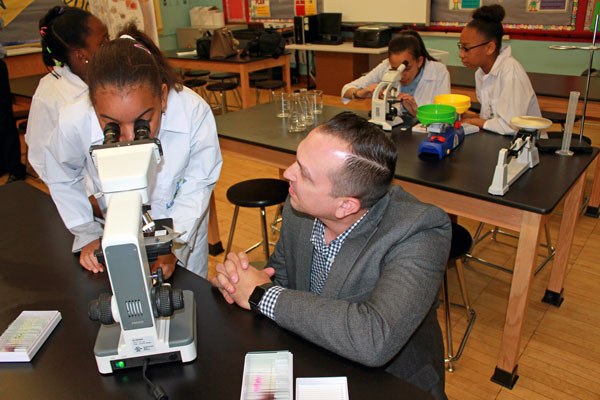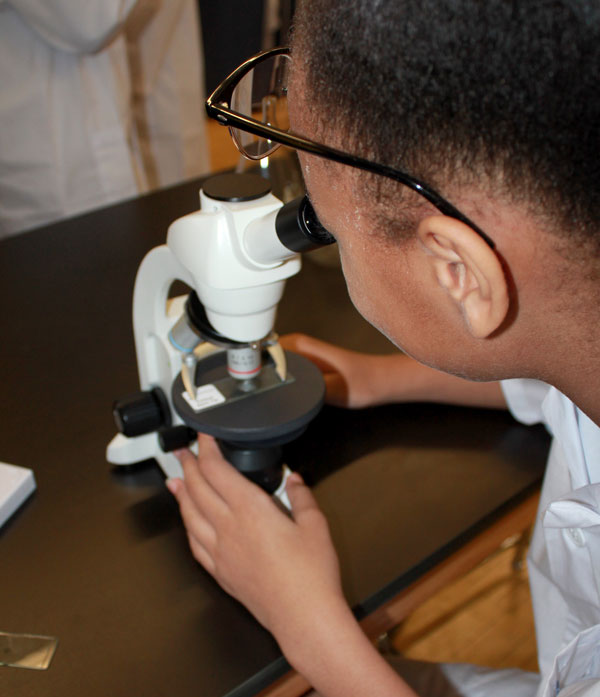
Looking like a real scientist in a white lab coat, Kaylis Gutierrez stepped forward to the microscope and peered into its eyepiece at a prepared slide of plant cells. She observed that they looked like little blocks, and smiled when she realized she could sharpen the focus with the twist of a knob.
A fifth-grader at Salve Regina Catholic Academy, East New York, Gutierrez says she wants to be a science teacher in a Catholic school one day.
“I think science is pretty cool and I’d like to teach students how to do experiments,” she said.
Gutierrez is getting a great foundation for her future career with a hands-on education in her school’s new STEM lab.
State-of-the-Art Labs
Salve Regina is one of 20 Catholic elementary schools in Brooklyn and Queens that will have state-of-the-art LabLearner labs up and running by this fall. LabLearner is a comprehensive science system that is used as a platform for science, technology, engineering and math (STEM)-related learning.
Schools do their part by allocating space for a designated lab room, and LabLearner does the rest – from installing the lab and supplying top notch equipment, to providing a complete curriculum and teacher training. Classrooms can be furnished with up to six stations to accommodate 36 students at a time.
Each lab costs around $90,000, and this initiative has been made possible through grants from the St. Elizabeth Ann Seton Trust, a fund supported by diocesan parishes in an effort to strengthen Catholic education through enrichment programs.
Other programs funded by the trust include the Performing Arts Residency, the Latin and Greek Roots Challenge and Catholic Identity Links.
“Having STEM labs allows us to continue to provide students with the essential elements of a quality Catholic education and keeps us focused on student achievement,” said Dr. Thomas Chadzutko, diocesan superintendent of Catholic schools.
LabLearner provides schools with the entire curriculum and materials they need, from lesson plans to experiments. The curriculum is organized by scientific themes that integrate biology, earth science, chemistry and physics Fundamental concepts are taught and built upon, year by year, using a hands-on, interdisciplinary approach that is grade-appropriate.
As the curriculum progresses, so too does the equipment. Higher-level tools are available as students move from primary to middle school and junior high.
Standard-based Curriculum
The program meets Common Core standards in mathematics and English, and is fully aligned with Next Generation Science Standards.
“STEM has to be so perfectly coordinated because while you want to interact technology, math and science, all of them still have to be at the right developmental level,” explains LabLearner founder, Dr. Keith Verner.
Dr. Verner is the former chief of developmental pediatrics and learning at Penn State University’s College of Medicine in Hershey, Pa.
In his work, he studied how children learn and how their brains process information. And what he discovered was that there was a disparity between what is known about how the brain learns, and how students were being taught in schools.
That prompted him to develop the LabLearner model in 1996 as a better and more practical way to teach children science. The system is used in schools around the country.
Salve Regina was one of the first in the diocese to introduce the program back in January. Installations will continue at other academies and schools into the fall.
“We wanted a hands-on program, so when the opportunity came up, I jumped on it,” said Roxanna Elder, Salve Regina’s principal.
“We’re constantly reading and talking, but with science, if you’re not touching and feeling and seeing, they don’t get the full learning process.”
From day one, her students have loved the lab, especially the younger grades. “They’re so excited and engaged and motivated because they’re able to touch things and not get in trouble for it,” she said.
Fostering Confidence
 Accidents do happen and when beakers break, Elder said teachers don’t make a fuss. They want children to feel confident and enjoy their exploration of the lab without fear.
Accidents do happen and when beakers break, Elder said teachers don’t make a fuss. They want children to feel confident and enjoy their exploration of the lab without fear.
“I think that increases their level of engagement, and the more engaged a student is, the more they learn,” she said.
Every class from nursery on up gets to visit the lab each week, and Mondays are reserved solely for seventh and eighth grades. They spend the day collaborating on experiments, thinking critically and solving problems.
“I’m a visual learner so when I see something, I understand it more,” said Alexis Acosta, a seventh grader at Salve Regina.
“If you’re just talking to me and not showing it to me, I get it but…” she said, her voice trailing off. “But now in the STEM lab, we have more hands-on projects than ever before.”
And Elder says teachers are just as enthusiastic as the students. She believes one of the reasons is because they have ongoing support. LabLearner provides on-site training, tools and resources in print and online, and staff scientists are always available to answer questions.
“The teachers just have to set it up and follow the program – it’s beautiful,” Elder said. “It is probably the best program we have here.”
Dr. Verner says he’s particularly proud to partner with Catholic schools because as a Catholic himself, he knows they offer students a strong moral compass, which he believes will be essential as ethical issues in science and technology continue to evolve in today’s world.
Also essential in his eyes: encouraging young people, like Kaylis Gutierrez, to become “really good science teachers,” so that they can share their love of learning and inspire the next generation of great scientists and innovators.









